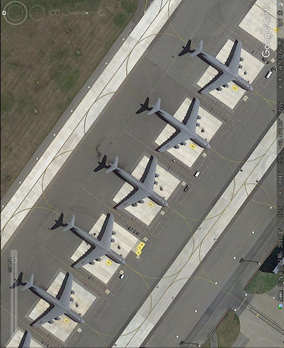本文转载自:https://wanghao.blog.csdn.net/article/details/105821398
在制作做遥感图像物体检测数据集的时候,遥感图像的物体都是平面的,有角度的问题,
可以对被检测物体实现不同角度的旋转,丰富数据集同时减少标注的工作量。

比如上图中的飞机,机头的朝向是斜向下的,现实中的飞机可能有各种的朝向,如果不做旋转,就会降低模型的检测能力。下图是旋转90度的效果。

需要安装的包:
labelme
scipy1.0.0版本
旋转最大的难点在于旋转后,需要对标注的点重新计算,保证标注的坐标不出现错乱。
旋转90度后,坐标转化:
points=shapelabel[‘points’]#获取初始的坐标。
newPoints = [[float(points[0][1]), w-float(points[1][0])],
[float(points[1][1]), w-float(points[0][0])]]#旋转90度,重新对应坐标。w表示原始图像的宽度。
选旋转180度后,坐标转化:
points = shapelabel[‘points’]
newPoints = [[w-float(points[1][0]), h - float(points[1][1])],
[w-float(points[0][0]), h - float(points[0][1])]] #旋转180度,重新对应坐标。h表示原始图像的高度。
旋转270度,坐标转化:
points = shapelabel[‘points’]
newPoints = [[h - float(points[1][1]), float(points[0][0])],
[h - float(points[0][1]), float(points[1][0])]]
完整代码如下:
#scipy的版本为1.0.0
import scipy
from scipy import misc
import os
import glob
import PIL.Image
from labelme.logger import logger
from labelme import PY2
from labelme import QT4
import io
import json
import os.path as osp
import PIL.Image
from scipy import ndimage
import base64
from labelme import utils
def load_image_file(filename):
try:
image_pil = PIL.Image.open(filename)
except IOError:
logger.error('Failed opening image file: {}'.format(filename))
return
# apply orientation to image according to exif
image_pil = utils.apply_exif_orientation(image_pil)
with io.BytesIO() as f:
ext = osp.splitext(filename)[1].lower()
if PY2 and QT4:
format = 'PNG'
elif ext in ['.jpg', '.jpeg']:
format = 'JPEG'
else:
format = 'PNG'
image_pil.save(f, format=format)
f.seek(0)
return f.read()
def dict_json(flags,imageData,shapes,imagePath,fillColor=None,lineColor=None,imageHeight=100,imageWidth=100):
'''
:param imageData: str
:param shapes: list
:param imagePath: str
:param fillColor: list
:param lineColor: list
:return: dict
'''
return {"version":"3.16.4","flags":flags,"shapes":shapes,'lineColor':lineColor,"fillColor":fillColor,'imagePath':imagePath.split('\\')[1],"imageData":imageData,'imageHeight':imageHeight,'imageWidth':imageWidth}
def get_image_paths(folder):
return glob.glob(os.path.join(folder, '*.jpg'))
def create_read_img(filename):
data = json.load(open(filename.split('.')[0]+'.json'))
shapes = data["shapes"]
version = data["version"]
flags = data["flags"]
lineColor = data["lineColor"]
fillColor = data['fillColor']
newshapes = []
im = misc.imread(filename)
h,w,d=im.shape
img_rote_90 = ndimage.rotate(im, 90)
img_path_90=filename[:-4]+'_90.jpg'
scipy.misc.imsave(img_path_90,img_rote_90)
imageData_90 = load_image_file(img_path_90)
imageData_90 = base64.b64encode(imageData_90).decode('utf-8')
imageHeight =w
imageWidth = h
for shapelabel in shapes:
newLabel=shapelabel['label']
newline_color=shapelabel['line_color']
newfill_color=shapelabel['fill_color']
points=shapelabel['points']
newPoints = [[float(points[0][1]), w-float(points[1][0])],
[float(points[1][1]), w-float(points[0][0])]]
newshape_type=shapelabel['shape_type']
newflags=shapelabel['flags']
newshapes.append({'label':newLabel,'line_color':newline_color,'fill_color':newfill_color,'points':newPoints,'shape_type':newshape_type,'flags':newflags})
data_90 = dict_json(flags, imageData_90, newshapes, img_path_90, fillColor, lineColor, imageHeight, imageWidth)
json_file = img_path_90[:-4] + '.json'
json.dump(data_90, open(json_file, 'w'))
img_rote_180 = ndimage.rotate(im, 180)
img_path_180=filename[:-4]+'_180.jpg'
scipy.misc.imsave(img_path_180,img_rote_180)
imageData_180 = load_image_file(img_path_180)
imageData_180 = base64.b64encode(imageData_180).decode('utf-8')
imageHeight = h
imageWidth = w
newshapes = []
for shapelabel in shapes:
newLabel = shapelabel['label']
newline_color = shapelabel['line_color']
newfill_color = shapelabel['fill_color']
points = shapelabel['points']
newPoints = [[w-float(points[1][0]), h - float(points[1][1])],
[w-float(points[0][0]), h - float(points[0][1])]]
newshape_type = shapelabel['shape_type']
newflags = shapelabel['flags']
newshapes.append(
{'label': newLabel, 'line_color': newline_color, 'fill_color': newfill_color, 'points': newPoints,
'shape_type': newshape_type, 'flags': newflags})
data_180 = dict_json(flags, imageData_180, newshapes, img_path_180, fillColor, lineColor, imageHeight, imageWidth)
json_file = img_path_180[:-4] + '.json'
json.dump(data_180, open(json_file, 'w'))
img_rote_270 = ndimage.rotate(im, 270)
img_path_270=filename[:-4]+'_270.jpg'
scipy.misc.imsave(img_path_270,img_rote_270)
imageData_270 = load_image_file(img_path_270)
imageData_270 = base64.b64encode(imageData_270).decode('utf-8')
imageHeight = w
imageWidth = h
newshapes = []
for shapelabel in shapes:
newLabel = shapelabel['label']
newline_color = shapelabel['line_color']
newfill_color = shapelabel['fill_color']
points = shapelabel['points']
newPoints = [[h - float(points[1][1]), float(points[0][0])],
[h - float(points[0][1]), float(points[1][0])]]
newshape_type = shapelabel['shape_type']
newflags = shapelabel['flags']
newshapes.append(
{'label': newLabel, 'line_color': newline_color, 'fill_color': newfill_color, 'points': newPoints,
'shape_type': newshape_type, 'flags': newflags})
data_270 = dict_json(flags, imageData_270, newshapes, img_path_270, fillColor, lineColor, imageHeight, imageWidth)
json_file = img_path_270[:-4] + '.json'
json.dump(data_270, open(json_file, 'w'))
print(filename)
img_path = 'USA' #这个路径是所有图片在的位置
imgs = get_image_paths(img_path)
print (imgs)
for i in imgs:
create_read_img(i)






评论(0)
您还未登录,请登录后发表或查看评论